File homemade hot dogs in the “because I can” category. The truth of the matter is that Sean and I like hot dogs, so generally the fewer questions we ask about what they’re made of, the better. However, since I’ve gathered all the tools (grinder, stuffer, smoker), I’ve been itching to try to make them myself. In fact, hot dogs were second only to home-cured bacon on my DIY charcuterie wishlist.
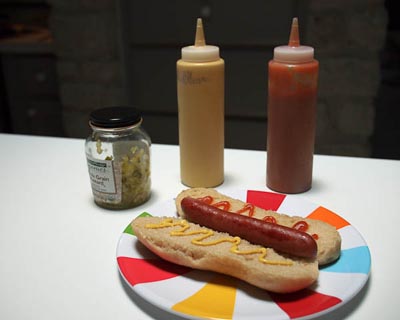
Like many of my endeavors, it wasn’t enough to just make hot dogs. I had been messing around with a good hamburger bun recipe, so I decided to (try to) adapt the shaping for hot dogs instead. (More on this recipe later this week.)
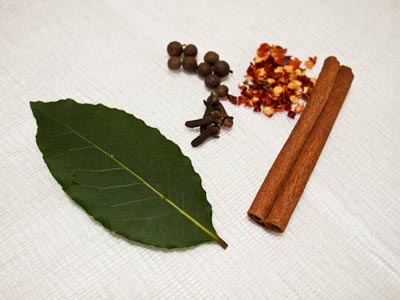
Also, it just so happened that we had gotten a 5-pound bag of the less than perfect tomatoes as an add-on to our regular CSA box one week. Despite their appearance, the flavor of the tomatoes was still excellent, so they went into any number of dishes, not the least of which was homemade ketchup. Cloves, bay, cinnamon, red chile flakes, celery seed, and allspice flavored a mixture of tomatoes, onion, chile, vinegar, and sugar to produce the first ketchup I have actually actively liked. Sean declared it too thin for french fry dipping, but otherwise it’s flavor was quite good (and I expect I can fix the consistency issues on a second attempt).
Since I had made the ketchup, it was important that I also make the mustard, so I took a shot at this incredibly simple recipe from Alton Brown. I was interested in a simple yellow mustard, and this one is close. One recipe note. I attempted to blend it with a stick blender, but the mustard never thickened up. It wasn’t until I abused it with my Vitamix that it thickened properly. In the end, it turned out to be very sharp, which I thought was very flavorful. If this is not to your liking, I’m guessing the heat of the mustard can be mitigated by adding a bit more vinegar.
I made relish too, though that was simply a matter of chopping up pickles I had already made. My reigning favorite all-purpose pickled cucumber recipe is Alton Brown’s Kinda Sorta Sours. Chopped up and dumped into a re-purposed mustard jar, they made an excellent tart relish for these hot dogs.
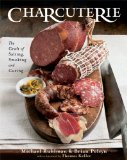


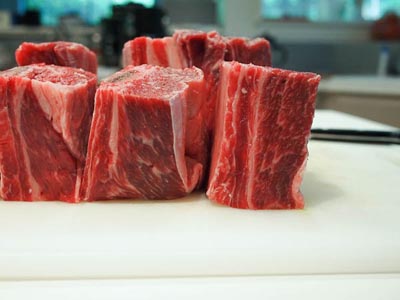
The first step was to remove the short rib meat from the bone, and then trim it of sinew and cut it into a large dice. This was immediately sent through the grinder’s smaller grinding plate and mixed with salt, pink salt, and water.
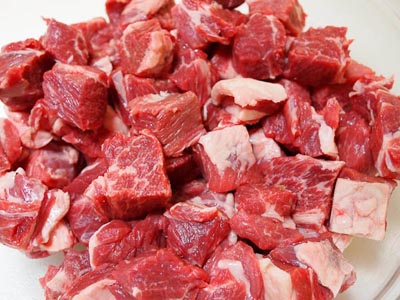
Funny aside: When I was running the short rib meat through the grinder, there was some rather explosive meat-juice spatter as the meat pushed through the grinder plate. Unfortunately, my Charcuterie book was in the line of fire. The hot dog pages were heavily splattered with brownish beef juice, and now not only are they spatter, they’re also crinkly and misshapen from my failed attempts and wiping off my mess with a wet towel. I’ve heard it said that cookbooks are meant to get dirty, so I guess I’m in the clear.
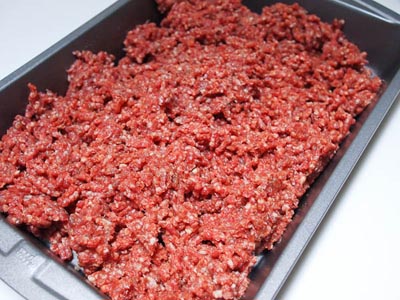
After a 24-hour rest, dry mustard, paprika, coriander, white pepper, garlic, and light corn syrup were mixed into the ground short ribs. I spread this out in a 13"x9" dish and shoved it in the freezer for a half-hour to firm up. The key to sausage making success is to keep everything as cold as possible. This is doubly true for an emulsified sausage like a hot dog.
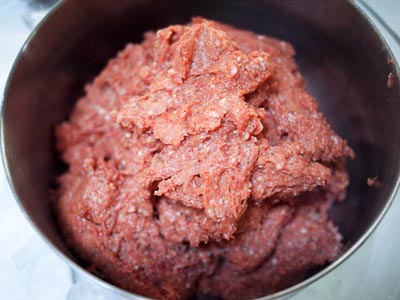
Once the meat mixture was semi-firm, it was again sent through the smaller grinder plate. Again, it was shoved in the freezer for a 30 minute rest. In two batches, I ran this through the food processor for maybe a minute till it was very fine and pasty. The idea is to get a uniform texture without letting the mixture get to warm. I expect mine was perhaps not quite so fine as it should have been, but it turned out nicely all the same.
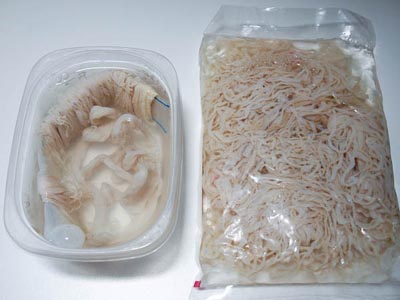
Hog casings on the left, much tinier sheep casings on the right
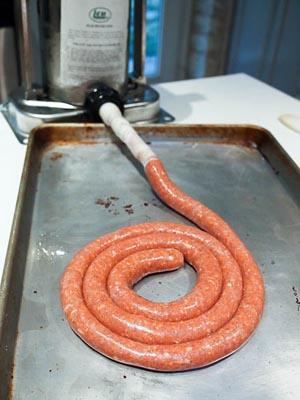
This was then stuffed into sheep casings. Sheep casings differ from hog casings (other than the obvious differences in origin) in a couple of important ways. First, they are much smaller in diameter, making them ideal for hot dogs and breakfast sausages. Second, the casing walls are much thinner. This should seem like a no-brainer, yet I had to learn it and relearn it through the course of stuffing the hot dogs.
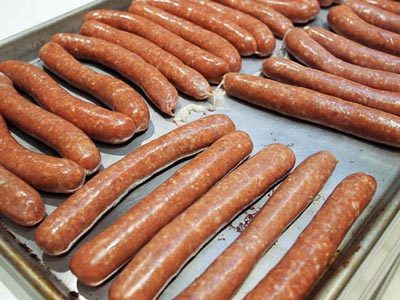
After they were fully stuffed and twisted into links, I left them to sit overnight in the refrigerator so they could dry a bit and develop a nice tacky skin for the smoke to adhere to. Here’s where I encountered another problem. The thin membrane of the sheep casings dried out very quickly – so quickly in fact that the hot dogs themselves had started to shrivel a bit. Note to future self: do not let them sit uncovered for a full day before smoking them.
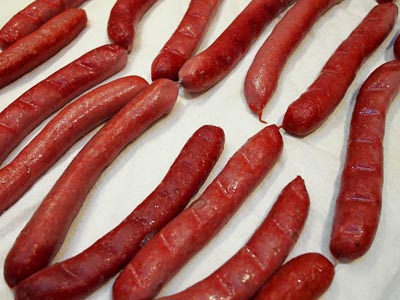
I don’t have a proper smoking setup to hand the sausages and let them color without grill marks, but that didn’t seem to hinder them fully cooking and tasting wonderful. The luscious fatty beef was a good partner to the aggressive seasonings. The flavor we’ve come to recognize in store-bought hot dogs is definitely there, but it’s like the best possible version of a hot dog. Succulent, flavorful, delicious.